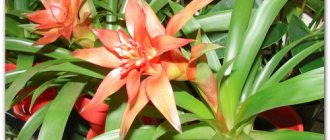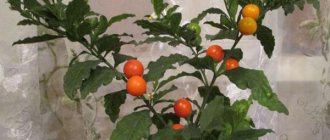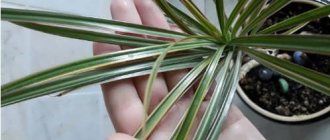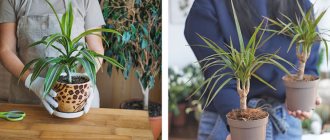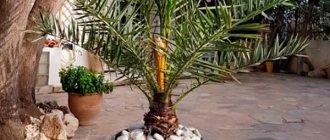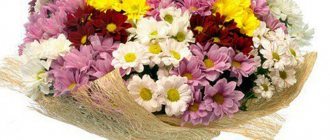Home — Botany — Houseplants — Turning the house into a tropical garden — basic recommendations for caring for Guzmania
The Guzmania indoor flower is an epiphyte from South and Central America. In nature, it grows on dying trees and receives moisture from the air. In indoor culture, this is an ordinary potted plant, quite unpretentious, but requiring compliance with several simple conditions.
The bright bracts are mistaken for flowers. Real Guzmania flowers are inconspicuous and short-lived.
The plant is evergreen tuft of long leaves with a bright, beautiful pre-flower and a short-lived flower. Guzmania is valued precisely for the leaves surrounding the flower - they can be pink, brownish and yellow, bright red and burgundy. In a room it rarely grows more than 40 cm, since it is problematic to provide “tropical” conditions in our homes.
Reed, aka Minor.
Popular types
Most often you can see a photo with reed Guzmania (aka Guzmania minor) - its distinctive features are bright bracts, shiny green leaves and the ability to bloom for a long time.
Tempo has light green leaves.
Common varieties also include:
- Mosaic Guzmania Guzmania musaica with 70-centimeter leaves forming a spreading rosette and a straight peduncle. Its leaves are decorated with brown and green stripes, and the bottom is colored red.
- Blood red Guzmania sanguinea - during the flowering period, all leaves (except for the outermost ones) turn bright red. The inflorescence of this species is not developed and is immersed in a rosette.
- Guzmania Donnell-smithii (donnell-smithii) has pale green scaly leaves and an erect flower stalk.
- Guzmania Tempo Guzmania Tempo, with light green leaves and bright bracts.
Blood red with luscious dark leaves and red spots of false flowers.
Examples of flowers with white-green, striped, colored leaves
The leaves of houseplants come in not only different shapes, but also different colors. It is possible to find striped, speckled, two and multi-colored:
- Flowers with white-green leaves include some types of tradescantia, chlorophytum, ficus, hosta, and pedilanthus.
- The group of plants with stripes on leaves includes arrowroot, calathea, aphelandra, mother-in-law's tongue, corn palm, and some types of dracaena.
- Crotons with multi-colored leaves include akalifa, caladium, cordyline, irezina, some types of Tradescantia with pink shades, and croton.
For reference: the leaves of indoor flowers can be smooth, rough or velvety.
The variety of varieties and species allows you to choose a plant with an interesting appearance.
Chlorophytum can be not only monochromatic, but also striped
Basic requirements of Guzmania - light, temperature, humidity
Even such an unpretentious home flower as Guzmania requires compliance with certain conditions.
Many amateur aquarists breed angelfish at home; it is not difficult. How many people know what this name of popular aquarium fish means?
Look right now how beautiful and unusual the ordinary garden lilac is!
So, it is placed on western or eastern windows, in partial shade . Guzmania can only be moved to the south side in winter - this compensates for the natural lack of light.
Important! There is no need to place this delicate epiphyte on the windowsill. During the heating season it will die due to low humidity, and in summer direct sunlight will cause severe burns.
As for the temperature , even novice gardeners will not have problems here: in summer 20-25 degrees is enough, and in winter - no lower than 17. If the temperature drops to 16 degrees, the plant may get sick or not want to bloom.
The Morente look seems to imitate the colors of autumn.
to humidity , because it comes from the tropics. In summer, take it out onto the loggia, and in winter, a lighted bathroom may be a suitable place. You can place a humidifier or indoor fountain nearby. Regularly add water to the pan, but do not let it stagnate. Guzmania will also like spraying - and in the heat, “showers” can be carried out 2 times a day.
Lemon guzmania with bright yellow bracts.
Photo gallery
Like numerous tropical representatives of the acanthaceae family, the herbaceous plant is a perennial, distinguished by inconspicuous flowers; the opposite leaves have a narrow ovate shape.
Rules for watering and fertilizing
Caring for Guzmania at home means maintaining an optimal microclimate and proper watering. The main recommendations here are:
- a small amount of water is poured directly into the outlet, and the remaining water is removed after a few minutes;
- water the soil rarely - only if it is very dry;
- In winter, 1-2 waterings per week are sufficient, and in summer, daily watering is required;
- overwatering is more dangerous for Guzmania than overdrying;
- For spraying, use only clean water, and to remove dust, the leaves are occasionally wiped with a cotton swab.
The magnificent Donella-Smith.
When Guzmania blooms, it needs mineral supplements . It is worth buying a special complex for bromeliads that dissolves in water. Fertilizers in the form of a solution are also applied to the outlet. The frequency of feeding is once a month.
Interesting! If Guzmania is in favorable conditions, but does not bloom, then place apple slices in a bag on the ground (just make sure that they do not become moldy over time). The fruit will release ethylene and the plant will bloom very quickly.
How to identify a houseplant by appearance
It is quite difficult to identify an indoor flower by appearance. It is not always possible to describe a plant correctly. However, if the description is detailed, with characteristics and features, then the likelihood of identifying the flower increases significantly.
Encyclopedia of indoor plants
There are several ways by which you can determine what species a plant belongs to:
- Encyclopedias. Directories are considered the most accurate, so the result of a search is often positive. The only drawback is outdated information that is rarely updated. In some cases, rare plants are almost impossible to find. The periodical press, of which there are many nowadays, also contains descriptions of flowers, but such publications only talk about some plants. To find what you need, you just need to subscribe and wait for it to appear in a magazine or newspaper.
- Internet. Search engines on the World Wide Web will help you find anything, provided that the request is made correctly. If you ask for information about a plant with white flowers and double leaves, you can get many answers. But choosing the right one will still be difficult. Therefore, it is necessary to compose the request in as much detail as possible in order to obtain accurate and correct information.
- Florist forums. Such communities are very popular and very often provide the necessary answer. Such information is often discussed on forums, and special groups are created to search for unknown plants. The result will be more accurate if you add a photo of the desired flower and contact different communities.
- Flower shops. If you cannot determine the name using the previous methods, it is recommended to visit large flower shops. Perhaps there will be a similar plant on the shelves. You can consult with the seller; they can also provide information on some rare varieties. It is better to take a photo of an unknown plant with you to the store.
- Specific online qualifiers. Such resources are quite popular. If you enter the information and characteristics correctly, it is quite possible to get the name of the desired flower. Queries are processed based on a huge database, so the likelihood of getting the correct answer is higher than with other methods.
Important! The choice of determination method depends on the preferences and wishes of the person. If necessary, you can try all the methods to get a reliable result.
Replanting Guzmania - when needed
The roots of the plant develop extremely slowly, and therefore it does not need regular replanting. But it’s still worth replanting Guzmania if:
- You purchased a flower in a transport pot . You need to prepare a wide pot, up to 15 cm deep, and place drainage at the bottom. A suitable soil mixture is a combination of coarse sand, sphagnum, peat and turf soil. Handle the roots carefully when transplanting. Lightly cover the relocated plant with soil and then water it.
- You separate the “baby” from the old bush . The replanting process is the same, but you will have to carefully separate the plant's root systems. The mother plant is not viable after flowering and is discarded.
Mosaic look. The transverse stripes on the leaves resemble a pike tail.
Calathea transplant at home
Planting calathea in a new pot is easy.
When to replant
The best time of year for replanting is early spring, when the calathea has recently emerged from hibernation, since a flowering or dormant pet may not be able to cope with the stress of moving to a new place.
Young (up to 3 years old) calathea must be replanted annually, and then once every two to three years. The main reason why a transplant may be required is that the pot has become “small”. This can be seen from the fact that the roots began to protrude from the ground - which means they have nowhere to grow.
Flowers are also replanted for sanitary purposes: for example, if you have over-watered and the plant has rotted (then it is often easier to replant than to wait for the soil to dry out), or if a fungus or pest has infested.
If transplantation is a measure of medical care, then it is carried out at any time of the year: it is more important to save the calathea than not to expose it to stress.
Priming
A slightly acidic soil that does not contain lime is suitable. This is, for example, the soil for azaleas and rhododendrons. You can also make the soil yourself.
So, what kind of soil is needed for planting calathea, what is the composition:
- You will need calcined river sand (it must first be placed in an oven heated to one hundred degrees for half an hour, and then left in a well-ventilated place for ten days so that beneficial microorganisms can grow there) - it will make up half of the soil mixture.
- The second half will be taken up by: leaf soil, humus, peat. As “vitamin supplements” you can put a little crushed coal (prevention against pests) or pieces of pine bark.
Pot
Small, since the root system of calathea usually does not grow too much. Each new pot is one third larger than the previous one (if the transplant is carried out for the reason “the previous pot has become small”). The material doesn't matter.
Action plan
- Prepare the pot and soil for replanting in advance. Also prepare a knife or scissors, because when replanting it is convenient to inspect the root system for rot and remove rotten parts.
To disinfect the sections you will need crushed activated carbon. You'll also probably need gloves to avoid getting soil on your hands.
- An hour before transplanting, water the calathea in an old pot generously - this will make it easier to get it out.
- Fill the new pot with a 2-3 cm layer of drainage. Sprinkle the drainage with a small layer of soil.
- An hour after watering, turn the pot over and carefully remove the calathea from it. Gently scrape the soil away from the roots or rinse them.
- Inspect for rotten (dark, brown or black) parts of the root system. If there is, it’s okay, just cut them off with a knife or scissors and sprinkle the sections with crushed activated carbon, and after that plant them in a new pot.
- Place the plant in the middle of the new pot. Holding with your hand so that it does not fall, fill in the remaining soil so that 1-1.5 cm of the pot remains empty (but keep in mind that after watering the soil will settle a little). Press the soil down, but not too tightly - the roots of the calathea need air, in this regard it is like an orchid.
- Water the plant immediately after transplanting and place it in the shade to allow it to adapt to the new conditions. The next watering is in 10 days. Done, landing was successful.
How to prolong the pleasure - propagating Guzmania
Growing this tropical beauty is easy. But there comes a time when the flower dies and the plant loses its decorative effect. You can preserve the “tropical paradise” if you know how Guzmania reproduces .
Even during the flowering period, the plant forms a “baby” - usually one. The young flower grows very quickly and by the time the “parent” dies, it will already reach 15 centimeters in height. It is easy to know that a plant is ready to divide: the bract begins to dry out and the leaves turn pale.
Important! Before dividing, check that the children have roots. If they grow poorly, remove the peduncle in advance - this will stimulate their development.
After the mother plant withers, the children can be separated - this is done with a sharp knife. Baby Guzmania should be immediately planted in the prepared substrate, and the pot should be small, because the plant is small. Remember to use drainage to prevent your young plant from dying from overwatering. Reproduction of Guzmania is not difficult, so very soon you will be delighted with new bright flowers.
Anthurium - how to grow, how to care for, how to propagate. This indoor flower is called male happiness, and it is believed that it brings love and harmony between spouses to the house.
It turns out that aloe can be grown not only for health, but also for beauty. More details can be found here.
What to do with the huge aerial roots of indoor monstera? The answer to this question can be found at the link www.razmnojenie.ru/botanika/komnatnye-rasteniya/monstera.html.
General description of the plant
Reo flower is a tropical perennial native to Mexico. Currently it belongs to the genus Tradescantia, although previously it was classified as an independent genus Reo (lat. Rhoeo). The flower received its mysterious name in honor of the ancient Greek deity of nature, the nymph Reo, so it is more correct to name the plant in the feminine gender, for example, Reo tepalsata.
Its other names are no less interesting - the Boat of Moses or the Cradle of Moses. Probably the plant acquired these names thanks to small white flowers, comfortably located among the bract leaves, reminiscent to some of a boat, and to others of a cradle rocking in the waters of the Nile with the biblical baby Moses. In the photo you can admire the flowering plant.
First of all, flower growers value Reo for its decorative foliage, which is not only monochromatic (green or purple), but also has stripes of different colors: white, pink or yellow. At the same time, its small delicate flowers in boat bracts are quite elegant and attractive.
The Reo flower was once brought to Europe and Russia from the tropics of Africa. It is valued by lovers of indoor plants, primarily for its decorative foliage. Reo's flowers are also quite beautiful. The long, narrow leaves of this plant are green on top and purple underneath. Sometimes striped varieties of Reo are also found on sale in specialized stores.
Description of Reo:
- has long sword-shaped leaves, painted greenish-olive on the outside and purple on the inside;
- some varieties have yellowish stripes;
- as it grows, the leaves fall off and the plant acquires an external resemblance to a palm tree;
- reaches a height of 30-40 cm;
- blooms briefly with small white flowers, regardless of the time of year;
- The stem is strong and erect.
Possible difficulties and diseases
Guzmania is easy to grow because it tolerates even unfavorable conditions. However, this plant also has its risks:
- The main pests that can affect Guzmania are: spider mites, scale insects. If parasites are found, wipe the leaves with soapy water, and if the infestation is severe, use insecticides.
- Regular waterlogging can lead to rotting of the root system.
- The plant may become infected with a fungus , as indicated by gray spots on the leaves. To get rid of it, you will need a fungicide.
The fungus began its destructive work from below.
